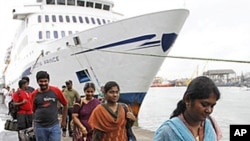Two years after a long, drawn-out civil war ended in Sri Lanka, ferry services have resumed between this island nation and neighboring India. The sea link across the Indian Ocean is expected to boost tourism and trade between the South Asian countries.
A cruise ship from Tuticorin in southern India sailed to Colombo, the capital of its Indian Ocean neighbor, then made a return trip this week.
The 14-hour journey across the narrow Palk Straits marked the first such crossing in 28 years. Passenger ferry services between the countries were suspended in 1983 due to security threats from Tamil Tiger rebels in Sri Lanka, who waged a violent separatist struggle.
But since the defeat of the Tamil Tigers in 2009, Palk Straits is now a safe zone, and Sri Lanka’s economy is rebounding.
A spokesman for Ceylon Shipping Corporation in Sri Lanka, Sunil Obedage, says the ferry service will facilitate the flow of tourists, traders and businessmen between the two countries.
“The response has been very good. It’s going to be 30 per cent cheaper than air fares. And we are allowing them 100 kilo baggage allowance. Indian tourists can get a visa on arrival, they don’t have a problem,” said Obedage.
Tourism was one of Sri Lanka’s hardest-hit industries by the civil war, as suicide bombings by Tamil Tigers scared away visitors from the tropical beaches of this tiny, island nation.
But they are now returning in large numbers. The country has witnessed close to a 50 per cent rise in the last two years. India accounts for the biggest portion, partly because the Tamil community in the south enjoys close linguistic and cultural links with Sri Lanka’s Tamil-speaking minority.
Hiran Cooray, chairman of the Pacific Asia Travel Association and a prominent Sri Lankan hotelier, says the ferry service is expected to draw in more tourists from India. He says hotel groups are expanding at a feverish pace to keep up with the demand.
“There is an investment boom here, existing properties are completely being transformed, new players are coming into the industry,” he said.
The Sri Lankan government is also rebuilding roads, rails and other infrastructure in the north and the east, where Tamil Tigers were based and which were devastated by the conflict. India is assisting the effort.
Cooray says hotel groups have drawn up plans to expand in these areas, which are among the most beautiful in the country.
“A lot of the development is happening in the east coast where the coastline is very long from the north of the country to the south of the country in the east, there are beautiful beaches out there, so people are buying and building,” he said.
India and Sri Lanka plan to start another ferry service between Sri Lanka’s northwestern town of Talaimannar and India’s Rameshwaram, but no date has yet been set.
India, Sri Lanka Resume Ferry Services After 30 Years











